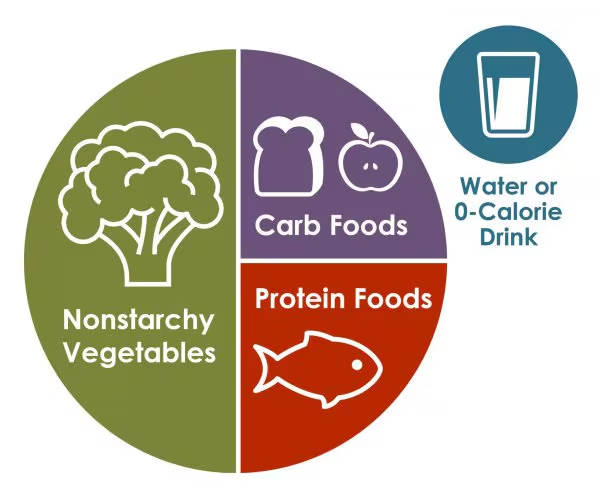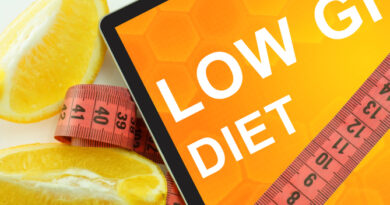How to Build a Diabetes-Friendly Plate
Managing diabetes can be easier with the right approach to meals. The foods you choose have a big impact on your blood sugar levels. Carbohydrates are the fastest source of energy, but too many can cause your blood sugar to spike. Protein and fats also provide energy, but they do so more slowly. By balancing your meals with the right combination of foods, you can keep your blood sugar more stable. Here’s a simple method to help you do just that.

Step 1: Fill Half of Your Plate with Non-Starchy Vegetables
Start with a standard 9-inch plate, roughly the size of a business envelope. Half of this plate should be filled with non-starchy vegetables. These veggies are packed with nutrients and have minimal effects on your blood sugar. They can also help protect against various diseases.
Common non-starchy vegetables to consider are:
- Broccoli
- Cauliflower
- Asparagus
- Artichokes
- Brussels sprouts
- Leafy greens like kale, spinach, and lettuce
- Zucchini and other summer squashes
Step 2: Fill One-Quarter of Your Plate with Lean Protein
Protein is essential for a balanced meal, and it doesn’t cause rapid spikes in blood sugar. Animal-based proteins like lean meats usually have little effect on glucose levels. Plant-based proteins contain some carbohydrates, but because they are high in fiber, their impact on blood sugar is minimal.
Some great protein choices include:
- Lean cuts of beef, pork, and lamb
- Poultry such as chicken or turkey
- Eggs
- Fish
- Soy products like tofu
- Nuts and natural nut butters
Step 3: Fill the Last Quarter of Your Plate with Healthy Carbohydrates
Carbohydrates are important for energy, but it’s best to opt for complex carbs. These are digested more slowly, which helps prevent blood sugar spikes. Simple carbs, like white bread, may give you a quick energy boost, but they also lead to quick drops in energy, leaving you feeling tired.
Some healthy complex carbs to include are:
- Whole grains like wheat, barley, quinoa, and oats
- Whole-grain bread, pasta, or tortillas
- Starchy vegetables such as sweet potatoes, peas, and winter squash
- Legumes like lentils and beans (black, kidney, pinto, and chickpeas)
Step 4: Include Healthy Fats
Healthy fats help you feel fuller for longer and have a slow effect on glucose levels. It’s more important to focus on the quality of fats rather than the quantity. Monounsaturated and polyunsaturated fats are the best options.
Good sources of monounsaturated fats include:
- Nuts like almonds and walnuts
- Natural nut butters
- Seeds such as chia, hemp, and sesame
- Avocado
- Olive oil
For polyunsaturated fats, try:
- Flaxseeds
- Fatty fish like salmon, tuna, and sardines
Step 5: Drink Water as Your Go-To Beverage
Liquids are absorbed quickly by the body, so they can raise your blood sugar faster than solid foods. The best option is plain water because it’s free of carbs, calories, and won’t affect your blood sugar. Plus, it’s easy to find and usually free.
Other healthy drinks include:
- Unsweetened coffee or tea
- Sparkling water without added sugar
- Flavored water made by adding a splash of 100% fruit juice or fresh slices of fruit, cucumber, or herbs
- Low-fat cow’s milk or plant-based milk with low carbs
Meal Ideas to Get You Started
To help you visualize the Diabetes Plate Method, here are some meal ideas:
1.Baked Chicken Breast with Mixed Green Salad
- Lean Protein: Baked chicken breast
- Non-Starchy Vegetables: Mixed leafy greens (such as kale, spinach, and romaine), cucumber, cherry tomatoes
- Carbohydrate Food: Whole-grain crackers or a small serving of brown rice
2.Quinoa Bowl with Roasted Vegetables and Chickpeas
- Lean Protein: Roasted chickpeas
- Non-Starchy Vegetables: Roasted bell peppers, red onion, mushrooms
- Carbohydrate Food: Quinoa (in moderation)
3.Baked Salmon with Steamed Broccoli and Sweet Potato
- Lean Protein: Baked salmon
- Non-Starchy Vegetables: Steamed broccoli
- Carbohydrate Food: Baked sweet potato (small portion)
4.Pan-Seared Tofu with Stewed Vegetables and Whole-Grain Noodles
- Lean Protein: Pan-seared tofu
- Non-Starchy Vegetables: Stewed vegetables (such as zucchini, carrots, and green beans)
- Carbohydrate Food: Whole-grain noodles (in moderation)
Final Thoughts
Managing diabetes doesn’t mean giving up tasty food or variety. The Diabetes Plate Method helps you create balanced, nutrient-rich meals that keep your blood sugar in check. By following this simple approach, you can still enjoy delicious meals while maintaining better control over your diabetes. Plus, you might even discover some new favorite foods along the way!



